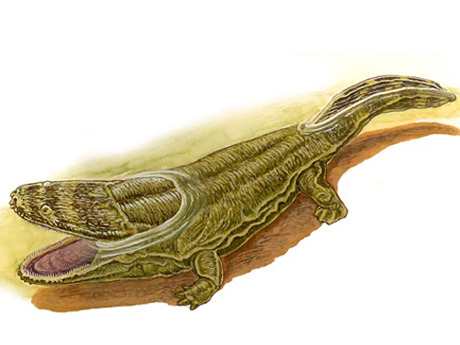Koskinonodon formerly known as Buettneria Mounted specimen on display at the American
Koskinonodon formerly known as Buettneria Mounted specimen on display at the American Museum of Natural History Reconstruction by Matt Celeskey When: Triassic (~228 - 216 million years ago) Where: North America What: Koskinonodonis one of the later surviving of the giant amphibians. This beast could read up to 10 feet (~ 3 meters) long and was very common in the ancient American southwest. Koskinonodon was known by the name Buettneria for over 80 years, until a long standing nomenclature problem was resovled. See, the name Buettneria was applied to this animal in honor of W. H. Buettner, a fossil collector in the first part of the 20th century. This was in 1922, however, a living species of katydid was given the genus name of Buettneria decades earlier in 1889. Thus the name was not actually availble to be used for this giant amphibian. The name Koskinonodon was applied in 2007. This name was used because a specimen that was named Koskinonodon in 1929 was later determined to belong to the same genus as the previously known specimens that were then called Buettneria. When a genus is renamed this is typically how it is done, you comb though the past literature and use the oldest available name that has ever been used for any species (or specimens!) now housed in that genus. Sadly sometimes you end up using names that are just not as cool as the original. Sorry W. H. Buettner. At least your namesake fossil lives on in outdated museum exhibits. ;) Koskinonodon is closely related to another large amphibian I have posted, Metoposaurus. It is likely that these two animals occupied the same habitates in life. What differentiates them? At just the general morphology level Koskinonodon has a much longer skull, a longer tail, and less robust limbs. It is common that when a paleo environment is reconstructed just one example of each ‘type’ of animal is used, but this is not really realistic. Think about the average North American forest today. Multiple species of all sorts of 'types’ of animals are found there, multiple squirrels, deers, and birds that resemble each other very closely but are distinct species. This is how it was in the Mesozoic world as well! -- source link
Tumblr Blog : dailyfossil.tumblr.com
#triassic#mesozoic#geology#biology#evolution#fossils#paleontology#science#amphibian#north america


